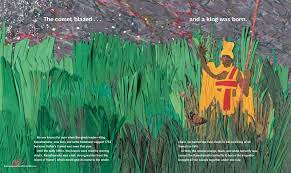"Spiny dogfish sharks are born alive in
litters that average six or seven pups.
These sharks spend up to 24 months in
the womb. They are born with a yolk
sac - their source of food in the womb -
still attached."
My year with books wouldn't seem right without a new book (or two) from this incredibly accomplished husband-and-wife team. It always surprises me a bit because I readily admit I am not, not, not a science aficionado. But I find myself very interested in the subjects they choose to tackle with an enormous amount of time spent on the careful research they do to inform young readers about so many topics of interest.
Now, you know and I know, that sharks are of very high interest to legions of school-age children. My younger granddaughter is not one of them ... too scary! Many kids have exactly the opposite reaction. The more they know, they happier they are. Steve Jenkins and Robin Page recognize that and are here with another remarkable book meant to inform fans.
Sharks are 'almost perfect predators' and they make a LOT of people uncomfortable and fearful.
"Some are big, fast, and dangerous, with powerful
jaws filled with razor-sharp teeth. Others are gentle
giants, cruising slowly through the sea as they feed
on shrimp and other tiny animals. The largest shark
is as big as a bus, while the smallest could fit in the
palm of your hand."
There are 42 species of sharks included here. Each double-page spread is filled with amazing facts that will help to make readers more aware of their many similarities and differences. They begin with a 'shiver of sharks', showing some that will be familiar, and others that will not be. A turn of the page shows a clearly labelled blue shark, mentioning each part of the shark's anatomy and why it is useful to them. The facts are fascinating and offer a very close look.
As readers move from spread to spread, they will see how different the sizes really are. Placed alongside a swimming adult human, readers will be astonished at the to scale size comparisons between a human and the sharks presented. Turn the page again, and the authors offer a comparison of their individual ways of giving birth - alive or hatched from an egg. Other topics include food, hunting techniques, jaws, big fish, hammerheads, peculiar species, glow-in-the-dark, adaptations, ancient relatives, record holders, attacks, and those that are endangered at this time.
If readers are fans of the creators, they will recognize the portrayals in always incredible torn- and cut-paper collage work. The sharks are realistic in both features and coloring. Carefully labelled and presented on white backgrounds, readers get a surprisingly authentic look at each entry. Having the human comparisons will bring some surprising responses. The images are as varied as the species, and the material provided is accessible and often remarkable.
"About 80 unprovoked shark attacks are
reported around the world every year. On
average, seven of these attacks are fatal.
In the same period, several thousand
people are killed by lightning and
thousands more drown. Rip tides
are much more dangerous than sharks."
Back matter includes a table that shows page number, name, average adult body length, danger to humans?, and conservation status for each shark presented. There is also a useful bibliography.
This engaging book will rarely be found on a bookshelf in the classroom, or in the library. Isn't that wonderful? Don't miss it!





























































